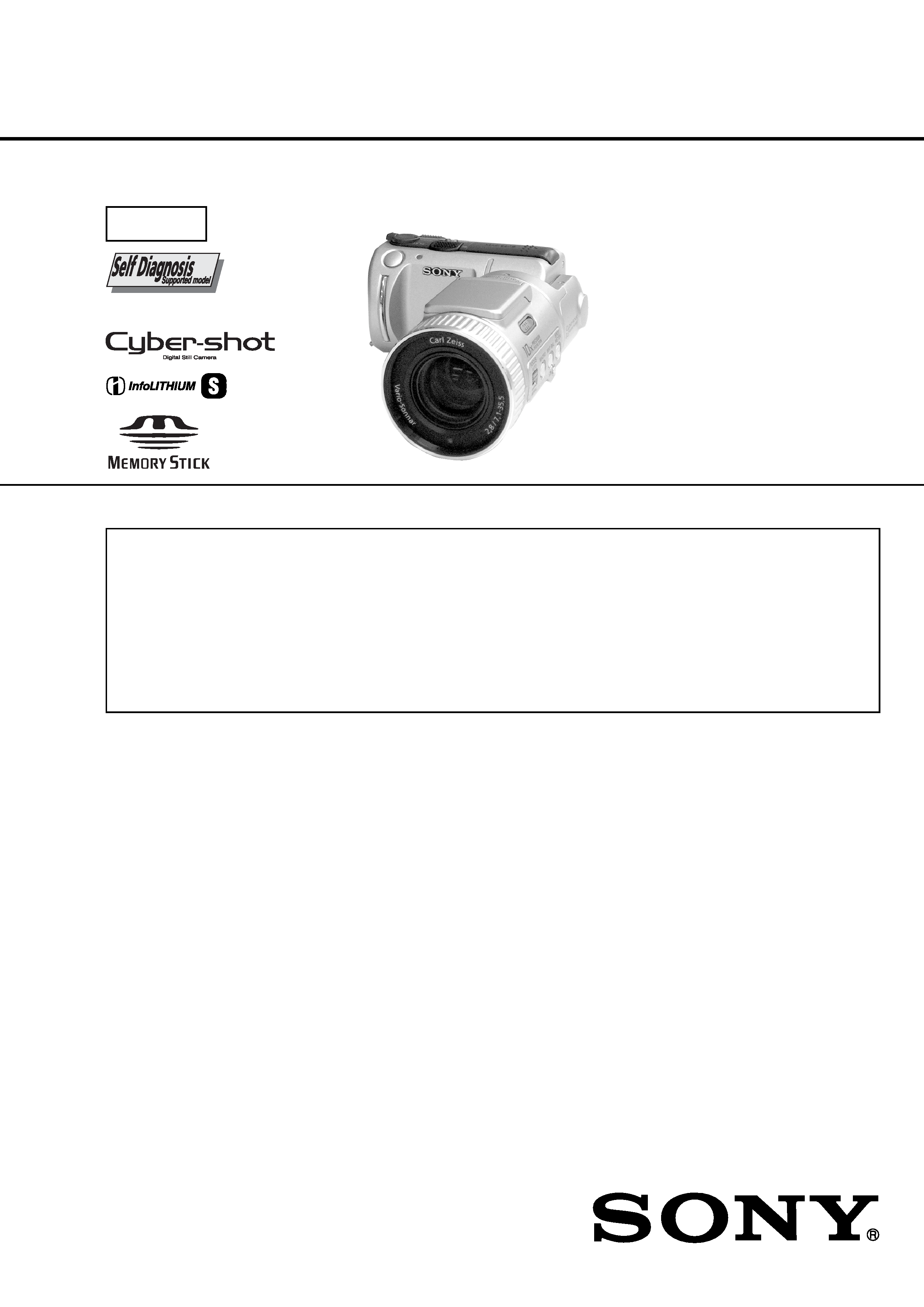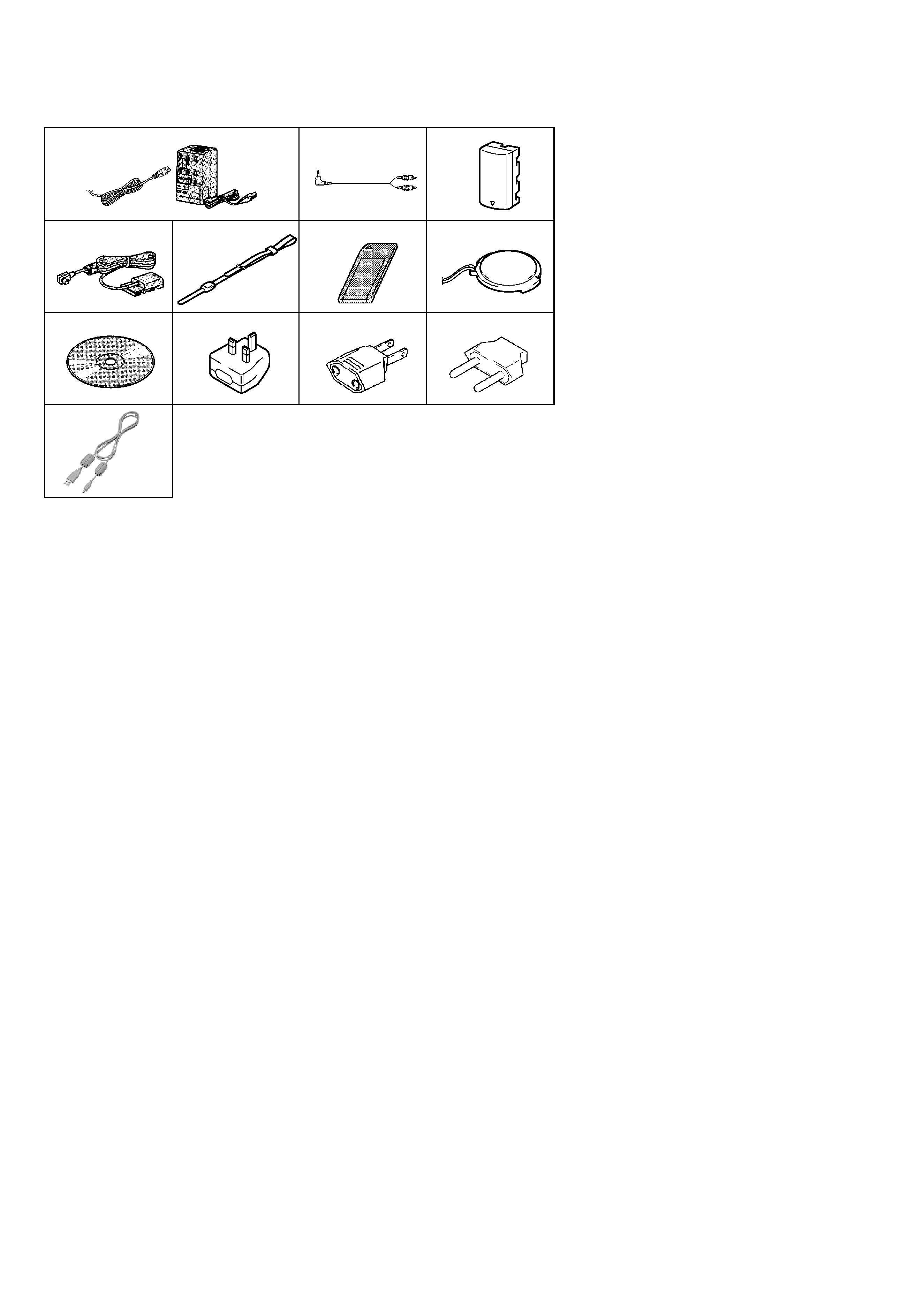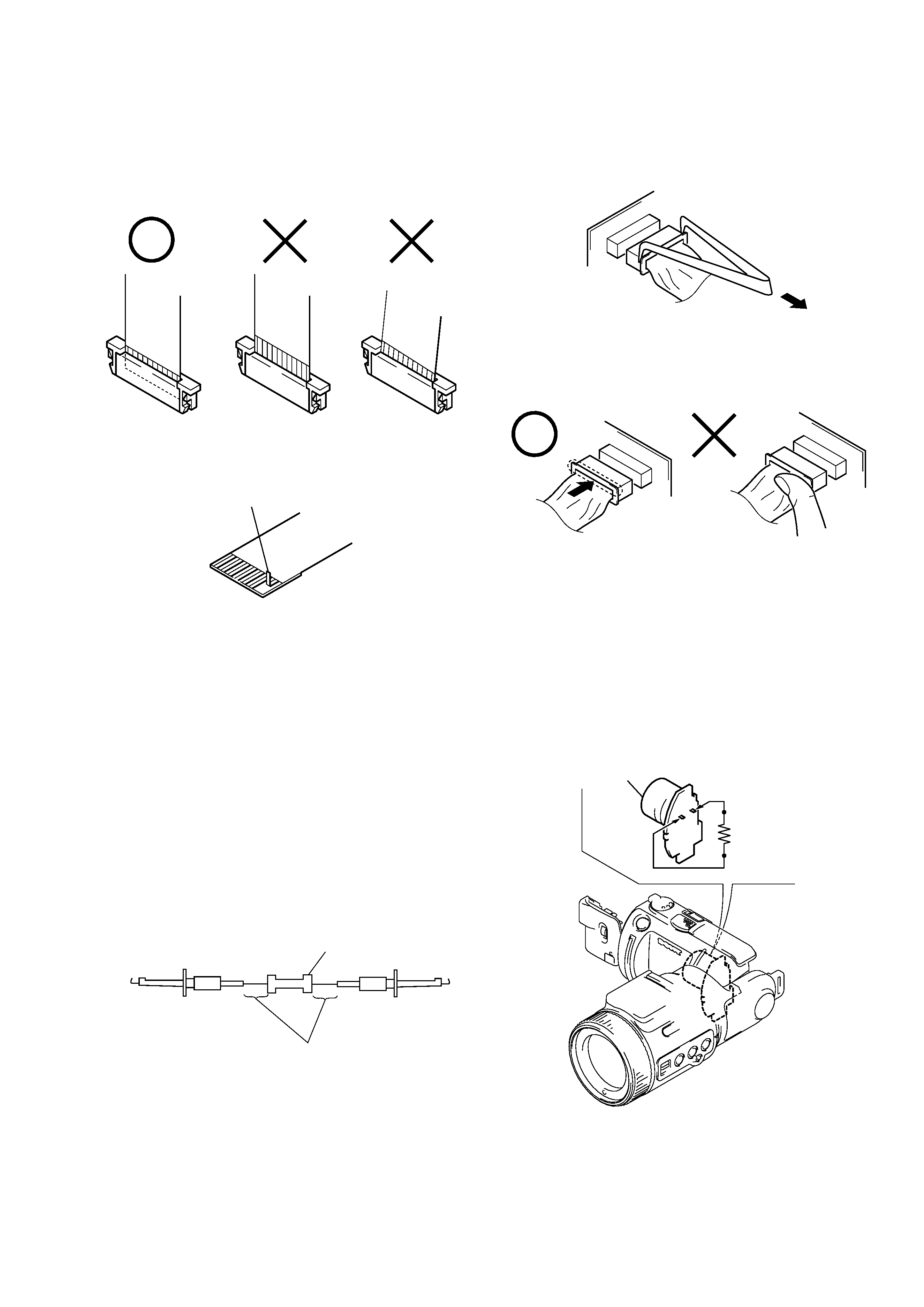
SERVICE MANUAL
DIGITAL STILL CAMERA
SPECIFICATIONS
DSC-F505V
Level 2
US Model
Canadian Model
AEP Model
UK Model
E Model
Hong Kong Model
Australian Model
Chinese Model
Korea Model
Tourist Model
Japanese Model
This service manual contains information for Japanese model as well.
On the PS-434, SY-62 boards
This service manual procides the information that is premised the
circuit board replacement service and not intended repair inside the
PS-434, SY-62 boards.
Therefore, schematic diagram, printed wiring board and electrical
parts list of the PS-434, SY-62 boards are not shown.
The following pages are not shown.
PS-434 board
Schematic diagram ..................................... Page 4-15 to 4-20
Printed wiring board ................................... Page 4-11 to 4-14
Electrical parts list ...................................... Page 6-13 to 6-14
SY-62 board
Schematic diagram ..................................... Page 4-23 to 4-26
Printed wiring board ................................... Page 4-21 to 4-22
Electrical parts list ...................................... Page 6-14 to 6-15
The above-described information is shown in service manual
Level 3.
System
Image device
1/1.8 type color CCD
Lens
5
× zoom lens
f = 7.1 35.5 mm
(38 190 mm when converted
into a 35 mm still camera)
F = 2.8 3.3
Exposure control
Automatic exposure
White balance
Automatic, Indoor, Outdoor,
One-push
Data system
Movie: MPEG1
Still: JPEG, GIF (in TEXT
mode), TIFF
Audio with still image:
MPEG1 (Monaural)
Recording medium
"Memory Stick"
Flash
Recommended recording
distance:
11 7/8 inches to 8 1/4 feet
(0.3 m to 2.5 m)
Output connector
A/V OUT (Monaural)
Minijack
Video: 1 Vp-p, 75
,
unbalanced, sync negative
Audio: 327 mV (at a 47 k
load)
Output impedance: 2.2 k
Digital I/O (USB)
Special minijack
External flash jack
Minijack
LCD screen
Used LCD panel
2 type TFT (Thin Film
Transistor active matrix) drive
Total number of dots
122,980 (559
× 220) dots
General
Used battery pack
NP-FS11
Power requirements
3.6 V
Power consumption
(during recording)
3.3 W
Operation temperature
32
°F to 104°F
(0
°C to 40°C)
Storage temperature
4
°F to +140°F
(20
°C to +60°C)
Maximum dimensions
Approx.
4 1/4
× 2 1/2 × 5 3/8 inches
(107
× 62 × 136 mm) (w/h/d)
Mass
Approx. 1 lb (475 g)
(including battery pack NP-
FS11, "Memory Stick," lens
cap, etc.)
Built-in microphone
Electret condenser microphone
Built-in speaker
Dynamic speaker
AC-VF10 AC power
adaptor/charger
Power requirements
100 to 240 V AC, 50/60 Hz
Rated output voltage
DC OUT: DC 4.2 V, 1.8 A in
operating mode
Battery charge terminal:
DC 4.2 V, 1.5 A in charge
mode
Operation temperature
32
°F to 104°F (0°C to 40°C)
Storage temperature
4
°F to +140°F
(20
°C to +60°C)
Maximum dimensions
1 15/16
× 1 9/16 × 3 3/8 inches
(49
× 39 × 85 mm) (w/h/d)
Mass
Approx. 4.2 oz (120 g)
NP-FS11 battery pack
Used battery
Lithium ion battery
Maximum voltage
DC 4.2 V
Nominal voltage
DC 3.6 V
Capacity
4.1 Wh (1 140 mAh)
Design and specifications are
subject to change without
notice.
Ver 1.1 2001.10

2
1. Check the area of your repair for unsoldered or poorly-sol-
dered connections. Check the entire board surface for solder
splashes and bridges.
2. Check the interboard wiring to ensure that no wires are
"pinched" or contact high-wattage resistors.
3. Look for unauthorized replacement parts, particularly transis-
tors, that were installed during a previous repair. Point them
out to the customer and recommend their replacement.
SAFETY CHECK-OUT
After correcting the original service problem, perform the following
safety checks before releasing the set to the customer.
4. Look for parts which, though functioning, show obvious signs
of deterioration. Point them out to the customer and recom-
mend their replacement.
5. Check the B+ voltage to see it is at the values specified.
6. Flexible Circuit Board Repairing
·
Keep the temperature of the soldering iron around 270 °C
during repairing.
·
Do not touch the soldering iron on the same conductor of
the circuit board (within 3 times).
·
Be careful not to apply force on the conductor when sol-
dering or unsoldering.
ATTENTION AU COMPOSANT AYANT RAPPORT
À LA SÉCURITÉ!
LES COMPOSANTS IDENTIFIÉS PAR UNE MARQUE 0
SUR LES DIAGRAMMES SCHÉMATIQUES ET LA LISTE
DES PIÈCES SONT CRITIQUES POUR LA SÉCURITÉ
DE FONCTIONNEMENT. NE REMPLACER CES COM-
POSANTS QUE PAR DES PIÈCES SONY DONT LES
NUMÉROS SONT DONNÉS DANS CE MANUEL OU
DANS LES SUPPLÉMENTS PUBLIÉS PAR SONY.
SAFETY-RELATED COMPONENT WARNING!!
COMPONENTS IDENTIFIED BY MARK 0 OR DOTTED
LINE WITH MARK 0 ON THE SCHEMATIC DIAGRAMS
AND IN THE PARTS LIST ARE CRITICAL TO SAFE
OPERATION. REPLACE THESE COMPONENTS WITH
SONY PARTS WHOSE PART NUMBERS APPEAR AS
SHOWN IN THIS MANUAL OR IN SUPPLEMENTS PUB-
LISHED BY SONY.
Supplied accessories
12
3
4567
890qa
qs
1
AC-VF10 AC power adaptor/charger,
Power cord (1)
2
A/V connecting cable (1)
3
NP-FS11 Battery pack (1)
4
DK-115 DC connecting cable (1)
5
Wrist strap (1)
6
Memory Stick (8MB) (1)
7
Lens cap/Lens cap strap (1)
8
CD-ROM (1)
9
Conversion plug 3P adaptor (1)
UK, Hong Kong model
0
2-pin conversion adaptor (1)
E model
qa
2-pin conversion adaptor (1)
Tourist model
qs
USB cable (1)

3
SERVICE NOTE ................................................................... 5
1.
GENERAL
Identifying the Parts ................................................................. 1-1
Preparing the Power Supply .................................................... 1-2
Setting the Date and Time ....................................................... 1-3
Inserting the "Memory Stick" ................................................... 1-4
Recording Still Images ............................................................ 1-4
Recording Moving Images ....................................................... 1-5
Playing Back Still Images ........................................................ 1-5
Playing Back Moving Images .................................................. 1-6
Viewing Images Using a Personal Computer ......................... 1-6
Image File Storage Destinations and Image Files .................. 1-7
Before Performing Advanced Operations ............................... 1-7
Various Recording ................................................................... 1-9
Various Playback ..................................................................... 1-11
Editing ..................................................................................... 1-12
Precautions .............................................................................. 1-14
On "Memory Sticks" ................................................................. 1-14
Using Your Camera Abroad ..................................................... 1-14
Troubleshooting ....................................................................... 1-14
Warning and Notice Messages ............................................... 1-15
Self-diagnosis Display ............................................................. 1-16
LCD Screen Indicators ............................................................ 1-16
2.
DISASSEMBLY
· Attachment of CPC-9 Jig ...................................................... 2-1
2-1.
Rear Cabinet Block ....................................................... 2-2
2-2.
Zoom Lens Block ........................................................... 2-2
2-3
Cabinet (LT) Block ......................................................... 2-3
2-4.
Lens Block ..................................................................... 2-3
2-5.
LCD Panel Block, Control Switch Block (FK) ............... 2-4
2-6.
HI-73, DD-148 Boards, Battery Holder Block ............... 2-5
2-7.
Upper Cabinet Block, Flash Unit (MC) ......................... 2-5
2-8.
Front Cabinet Assembly ................................................ 2-6
2-9.
Removal and Attachment of FP-37 Flexible Board ...... 2-7
2-10. To Fold the New FP-37 Flexible Board ......................... 2-7
2-11. Crystal Indication Module ............................................. 2-8
2-12. Flash Unit (ST) .............................................................. 2-8
2.13. Circuit Boards Location ................................................. 2-9
2-14. Flexible Boards Location ............................................... 2-9
3.
BLOCK DIAGRAMS
3-1.
Overall Block Diagram ................................................... 3-1
3-8.
Power Block Diagram 1 ................................................. 3-15
3-9.
Power Block Diagram 2 ................................................. 3-17
3-10. Power Block Diagram 3 ................................................. 3-19
4.
PRINTED WIRING BOARDS AND
SCHEMATIC DIAGRAMS
4-1.
Frame Schematic Diagrams .......................................... 4-3
Frame Schematic Diagram (1/2) ................................... 4-3
Frame Schematic Diagram (2/2) ................................... 4-5
4-2.
Printed Wiring Boards and Schematic Diagrams ......... 4-7
CD-283 Printed Wiring Board ....................................... 4-7
CD-283 Schematic Diagram ......................................... 4-9
HI-73 Printed Wiring Board ........................................... 4-27
HI-73 (LCD Drive) Schematic Diagram ......................... 4-31
HI-73 (Timing Generator) Schematic Diagram ............. 4-33
HI-73 (Video) Schematic Diagram ................................ 4-35
HI-73 (Audio) Schematic Diagram ................................ 4-37
HI-73 (USB I/F) Schematic Diagram ............................. 4-39
HI-73 (Hi Control) Schematic Diagram ......................... 4-41
DD-148 Printed Wiring Board ....................................... 4-43
DD-148 Schematic Diagram ......................................... 4-45
CN-121 Printed Wiring Board and
Schematic Diagram ....................................................... 4-47
FK Schematic Diagram ................................................. 4-49
TABLE OF CONTENTS
Section
Title
Page
Section
Title
Page
CF/MANUAL FOCUS BLOCK, ST
Schematic Diagrams ..................................................... 4-51
PW, MC Schematic Diagrams ....................................... 4-52
4-3.
Waveforms ..................................................................... 4-53
4-4.
Parts Location ............................................................... 4-56
5.
ADJUSTMENTS
Before Starting Adjustment ..................................................... 5-1
1-1.
Adjusting Items when Replacing
Main Parts and Boards .................................................. 5-2
5-1.
Camera Section Adjustment ......................................... 5-3
1-1.
Preparations Before Adjustment ................................... 5-3
1-1-1. List of Service Tools ................................................. 5-3
1-1-2. Preparations ............................................................. 5-4
1-1-3. Discharging of the Flashlight Power Supply ............ 5-4
1-1-4. Precautions .............................................................. 5-6
1. Setting the Switch .................................................... 5-6
2. Order of Adjustments ............................................... 5-6
3. Subjects .................................................................... 5-6
4. Preparing the Flash Adjustment Box ....................... 5-7
1-2.
Initialization of B, D, E, F, 7 Page Data ......................... 5-8
1-2-1. Initialization of D Page Data .................................... 5-8
1. Initializing D Page Data ............................................ 5-8
2. Modification of D Page Data .................................... 5-8
3. D Page Table ............................................................ 5-8
1-2-2. Initialization of B, E, F, 7 Page Data ........................ 5-9
1. Initializing B, E, F, 7 Page Data ................................ 5-9
2. Modification of B, E, F, 7 Page Data ........................ 5-9
3. B Page Table ............................................................ 5-9
4. E Page Table ............................................................ 5-9
5. F Page Table ............................................................. 5-10
6. 7 Page Table ............................................................. 5-11
1-3.
Video System Adjustments ........................................... 5-12
1.
Video Sync Level Adjustment ....................................... 5-12
2.
Video Burst Level Adjustment ....................................... 5-12
1-4.
Camera System Adjustment ......................................... 5-13
1.
HALL Adjustment .......................................................... 5-13
2.
Flange Back Adjustment
(Using the minipattern box) ........................................... 5-14
3.
Flange Back Check ....................................................... 5-15
4.
F No. Standard Data Input ............................................ 5-16
5.
Mechanical Shutter Adjustment .................................... 5-16
6.
Picture Frame Setting .................................................... 5-17
7.
Light Level Adjustment and ND Shutter Check ............ 5-18
8.
Mixed Color Cancel Adjustment .................................... 5-18
9.
Auto White Balance Standard Data Input ..................... 5-19
10. Auto White Balance ND Filter Compensation ............... 5-19
11. Auto White Balance Adjustment ................................... 5-20
12. Color Reproduction Adjustment .................................... 5-21
12-1.
Color Reproduction Adjustment
(Without ND Filter) ................................................... 5-21
12-2.
Color Reproduction Adjustment (With ND Filter) .... 5-21
13. Color Reproduction Check ............................................ 5-22
14. White Balance Check .................................................... 5-23
15. Strobe White Balance Adjustment ................................ 5-24
16. Strobe Light Level and White Balance Check .............. 5-24
17. CCD Black Defect Compensation ................................. 5-25
18. CCD White Defect Compensation ................................ 5-25
1-5.
LCD System Adjustments ............................................. 5-26
1.
LCD Initial Data Input .................................................... 5-27
2.
VCO Adjustment (HI-73 Board) .................................... 5-27
3.
D Range Adjustment (HI-73 Board) .............................. 5-28
4.
Bright Adjustment (HI-73 Board) ................................... 5-28
5.
Contrast Adjustment (HI-73 Board) .............................. 5-29
6.
Color Adjustment (HI-73 Board) ................................... 5-29
7.
V-COM Level Adjustment (HI-73 Board) ....................... 5-30
8.
V-COM Adjustment (HI-73 Board) ................................ 5-30
9.
White Balance Adjustment (HI-73 Board) ..................... 5-31
1-6.
System Control System Adjustments ........................... 5-32
1.
Battery Down Adjustment ............................................. 5-32
2.
ZOOM-VR Center Adjustment ...................................... 5-33
5-2.
Service Mode ................................................................ 5-34
2-1.
Adjusting Remote Commander ..................................... 5-34

4
Section
Title
Page
1.
Used Adjusting Remote Commander ........................... 5-34
2.
Precautions upon Using
the Adjusting Remote Commander ............................... 5-34
2-2.
Data Process ................................................................. 5-35
2-3.
Service Mode ................................................................ 5-36
1.
Setting the Test Mode .................................................... 5-36
2.
Bit Value Discrimination ................................................ 5-36
3.
Balance Sensor Check .................................................. 5-36
4.
Switch Check (1) ........................................................... 5-36
5.
Switch Check (2) ........................................................... 5-37
6.
REPAIR PARTS LIST
6-1.
Exploded Views ............................................................. 6-1
6-1-1. Battery Holder Assembly ......................................... 6-1
6-1-2. Front Cabinet Assembly ........................................... 6-2
6-1-3. Rear Cabinet Assembly ........................................... 6-3
6-1-4. Lens Cabinet Assembly ........................................... 6-4
6-1-5. Lens Assembly ......................................................... 6-5
6-2.
Electrical Parts List ....................................................... 6-6
* The color reproduction frame is shown on page 134.
The parts reference sheet is shown on page 135.

5
[Discharging of the FLASH unit's charging capacitor]
The charging capacitor of the FLASH unit is charged up to the
maximum 300 V potential.
There is a danger of electric shock by this high voltage when the
battery is handled by hand. The electric shock is caused by the
charged voltage which is kept without discharging when the main
power of the unit is simply turned off. Therefore, the remaining
voltage must be discharged as described below.
Preparing the Short Jig
To preparing the short jig, a small clip is attached to each end of a
resistor of 1 k
/1 W (1-215-869-11).
Wrap insulating tape fully around the leads of the resistor to pre-
vent electrical shock.
1 k
/1 W
Wrap insulating tape.
Discharging the Capacitor
Short-circuit between the positive and the negative terminals of
charged capacitor with the short jig about 10 seconds.
SERVICE NOTE
· NOTE FOR REPAIR
Make sure that the flat cable and flexible board are not cracked of
bent at the terminal.
Do not insert the cable insufficiently nor crookedly.
When remove a connector, don't pull at wire of connector.
It is possible that a wire is snapped.
Cut and remove the part of gilt
which comes off at the point.
(Be careful or some
pieces of gilt may be left inside)
When installing a connector, don't press down at wire of connector.
It is possible that a wire is snapped.
Flash unit (MC)
Capacitor
R: 1 k
/1 W
(Part code:
1-215-869-11)
